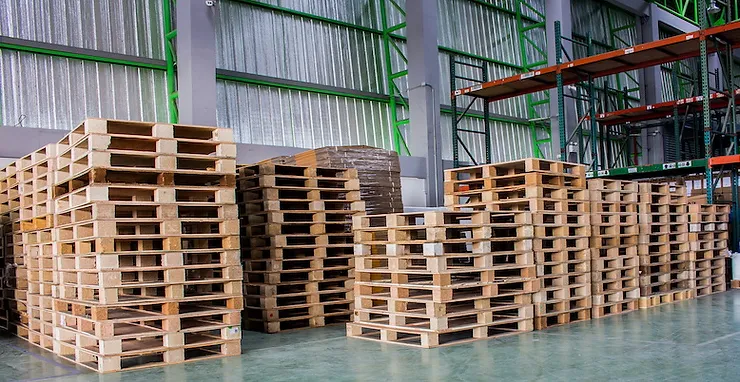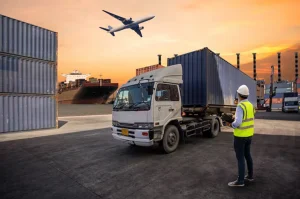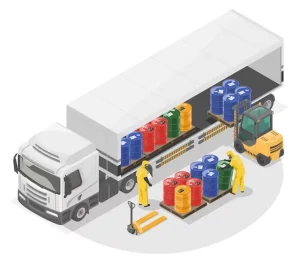What is a Pallet?
A pallet, in the context of logistics and shipping, is a flat, portable platform typically made of wood, plastic, or metal that is used for stacking, storing, and transporting goods. Pallets are designed to provide a stable base for goods, making it easier to move and handle them with forklifts, pallet jacks, and other material handling equipment. They play a crucial role in supply chains and logistics by simplifying the process of loading and unloading cargo as well as improving the efficiency of storage and transportation.
Pallets are essential in industries such as manufacturing, distribution, warehousing, and retail, where they facilitate the efficient movement of goods throughout the supply chain.
Pallet Sizes
When it comes to cargo shipping, there isn’t a standard “palllet” size, but there are some pallet sizes commonly used in the industry. They include:
Standard Pallet: The most common pallet size in North America is 48 inches by 40 inches (121.92 cm x 101.6 cm). This size is often referred to as a “GMA pallet” (Grocery Manufacturers Association pallet) and is widely used in various industries.
European Pallet: In Europe, the standard pallet size is 1200 mm x 800 mm (47.24 inches x 31.50 inches). This size is known as the EUR pallet and is commonly used in European logistics and transportation.
ISO Pallet: The International Organization for Standardization (ISO) has established the ISO pallet sizes, which include the 1200 mm x 1000 mm (47.24 inches x 39.37 inches) size as well as other sizes like 1100 mm x 1100 mm (43.31 inches x 43.31 inches).
Half Pallet: Half pallets, also known as “half-size pallets” or “midi pallets,” are smaller pallets used for lighter or more compact loads. They are typically around half the size of a standard pallet.
Quarter Pallet: Quarter pallets are even smaller, usually one-fourth the size of a standard pallet. They are suitable for small quantities or very lightweight cargo.
Custom Pallets: In some cases, businesses may use custom pallet sizes to accommodate specific products or logistical requirements. Custom pallets can vary widely in size and shape.
Pallet sizes: what must be taken into account?
Selecting the right pallet size for your cargo is a crucial decision that can impact your logistics, storage, and transportation efficiency. When determining the appropriate pallet size for your cargo, here are several factors you should take into account:
Size and Shape of Cargo: Consider the dimensions and shape of your cargo. The pallet size should be compatible with the size and shape of your goods. Ensure that your cargo fits comfortably on the pallet without overhanging or being too small for stability.
Weight of Cargo: Different pallets have weight capacity limits. Make sure the chosen pallet can support the weight of your cargo. If you’re dealing with exceptionally heavy items, you may need stronger pallets or additional reinforcement.
Transportation Mode: The mode of transportation you use (e.g., truck, container, air freight) can dictate the maximum pallet size you can use. Ensure your pallet size complies with the transportation equipment’s dimensions and weight restrictions.
Storage and Warehousing: If your cargo will be stored in a warehouse, consider the warehouse’s pallet racking system and storage space. The pallet size should fit comfortably on the shelving or storage racks.
International Standards: If your cargo is being shipped internationally, consider using standard pallet sizes like the ISO or EUR pallets, as these are more likely to be accepted and compatible with international shipping and logistics.
Handling Equipment: Ensure that the pallet size is compatible with the forklifts, pallet jacks, and other handling equipment used in your supply chain. Different pallet sizes may require different types of equipment.
Cost and Efficiency: Smaller pallets may be more cost-effective for lightweight or smaller items, while larger pallets can maximize space utilization for larger items. Consider the trade-off between efficiency and cost.
Product Packaging: The way your products are packaged can affect pallet selection. Bulkier or irregularly shaped packaging may require custom pallets or special consideration.
Regulatory and Industry Standards: Some industries have specific regulations or standards regarding pallet sizes. Ensure compliance with any relevant industry guidelines.
Load Stability: Cargo should be loaded in a way that ensures stability during transportation. Consider how your cargo will be loaded onto the pallet to prevent shifting or damage.
Customization: In some cases, you may need custom pallet sizes to meet unique cargo requirements. If so, work with pallet manufacturers to design pallets tailored to your needs.
Choosing the right pallet size involves careful planning and consideration of these factors to optimize your cargo handling, storage, and transportation processes while minimizing costs and risks. It’s often beneficial to consult with logistics experts or pallet suppliers to make informed decisions based on your specific cargo and supply chain needs.
TopTrans: Your Partner in Choosing the Right Pallet Size
At TopTrans, we understand that choosing the right pallet size is a critical decision in the world of international cargo transportation. It’s not just about selecting a piece of equipment; it’s about ensuring the safety and efficiency of your cargo. That’s why we offer expert guidance and a range of services to help you make the perfect choice.
Personalized Consultations
Our team of experienced logistics experts will work closely with you to understand your cargo’s unique requirements. Whether it’s the dimensions, weight, or fragility of your goods, we’ll recommend the ideal pallet size that ensures secure transportation.
Pallet Type Recommendations
Not all pallets are the same, and each type has its advantages. We’ll provide you with recommendations on whether wooden, plastic, or custom pallets suit your cargo best. Our goal is to optimize your pallet choice for both safety and cost-effectiveness.
Efficiency Insights
Pallet efficiency can impact your storage space and transportation costs. We’ll share insights on how to stack and utilize your chosen pallets efficiently. Maximize your space without compromising cargo safety.
International Shipping Expertise
For international shipments, adhering to dimensional standards is crucial. Our expertise in international logistics ensures your cargo complies with regulations, minimizing delays and complications.
Transparent Cost Breakdowns
We understand the importance of budget management. Our team will provide you with a transparent cost breakdown, including pallet costs and any additional services required. There are no hidden fees or surprises.
Eco-Friendly Options
If sustainability is a priority, we’ll introduce you to eco-friendly pallet options that align with your environmental values. Make responsible choices without compromising efficiency.
Pallet Management Support
Our commitment doesn’t end with pallet selection. We offer tracking and maintenance services to ensure your pallets are in optimal condition for reuse, further enhancing your cost savings.
How to Get Started
Choosing the right pallet size is the first step towards a seamless logistics journey. TopTrans is here to simplify the process and offer you peace of mind. Our customer service team is just a message or call away, ready to assist you in making the best choice for your cargo.
Don’t hesitate to reach out to us with any questions or to request a quick and competitive quote. Your cargo’s safety and efficiency are our top priorities, and we’re here to help you every step of the way. Choose TopTrans for a smoother logistics experience today!








